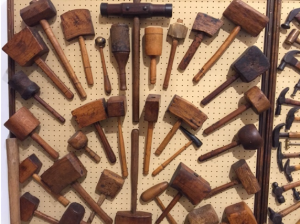by Dr. Ron Mahurin—DGI Senior Consultant and Principal, The Mahurin Group
With the fall season well underway, in my region of the world (outside Philadelphia), we’re bracing for the deluge of leaf dropping that is imminent. Even as I pen this blog looking out my office window, the late October winds are swirling and the leaves are fluttering downward with the sole purpose of planting themselves across my yard (and my neighbors as well?).
The Tried and True Method
As an experienced leaf collector, I’ve learned many a lesson regarding the most effective and efficient ways to collect leaves, and how to efficiently dispose of them. There’s the manual labor approach – all hand raking onto a large tarp, then dragging the leaves through the yard to properly dispose of them curbside where our very efficient township work crew will gather them.
- Advantages: I get a good cardiovascular and muscular workout. Quiet – allows for some contemplative thinking on a cool fall day.
- Disadvantage: Time-consuming, usually requires many hours of work. Most efficient if I have a partner (read spouse, another family member) to accomplish the task – that’s not always an available option.
Let’s go with Big Power
 Then there’s always the power tool option- the industrial leaf blower. You know the kind. You got to your local big box home improvement store, pay your $, and rent the largest blower you can to swiftly move those leaves off your lawn.
Then there’s always the power tool option- the industrial leaf blower. You know the kind. You got to your local big box home improvement store, pay your $, and rent the largest blower you can to swiftly move those leaves off your lawn.
- Advantage: speed, generally doesn’t require dosages of pain relief following the work.
- Disadvantage: Noise pollution, somewhat less control over where the leaves will end up (neighbor’s yard, for example), and I’m usually out about $50-60 per rental.
So the contrast between a) the tried and true and b) the more “advanced technological solution” may be a useful object lesson as we think about potential clean-up strategies for the clutter of proverbial dead leaves we face in higher education.
Some leaders are happy to stay with the “tools that they know.” They rely on familiar systems, processes, and select people because they can predict what they’ll get. To be sure, the tried and true method is elegant in simplicity and relatively efficient.
But what happens when the volume of work, the speed needed to accomplish the task, and the people required to accomplish the assignment are changing so quickly that our tried and true methods just cannot keep up? Or worse, don’t apply? It’s as if the trees are dropping leaves so fast that regardless of the number of people pulling the rakes, the mess just gets worse.
Choosing the Proper Tool
So here comes the common sense: “Don’t bring a knife to a gun fight.” “Don’t use a sledgehammer to crack a walnut.”

We are prone to think we need the latest and most sophisticated tools to do the job. But we also must pay attention to our tendency to over-think and over-tool. Sometimes, the simple approach will suffice.
As you reflect on your own organization, consider these few questions. Think about the tools that you have at your disposal.
- What are two or three strategic priorities that you want to accomplish in the next 12 months?
- What tools (personnel, financial resources, clear systems
and organizational direction, etc.…) are you planning to use to accomplish those priorities? - Are you in danger of “
over-tooling ” or over-thinking?
Stop. Reflect. Draw upon your experience and that of others on your team (or trusted advisors outside the institution). Simplify.
Identify the best tools. Make sure they are in good working order.
Ponder that for a bit. Then move into action.
On a fresh autumn day, you’ll clear the clutter, and breathe in the satisfaction of a job well done.
Let’s get to tooling!
/Ron%20Mahurin%20Headshot%20(300x300).png)
December 7, 2018
Comments